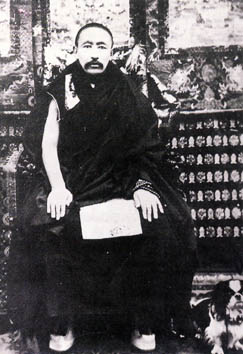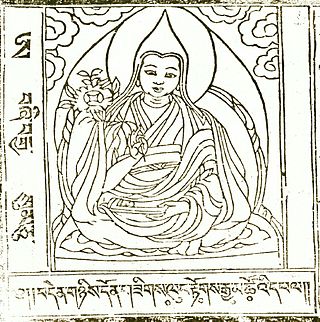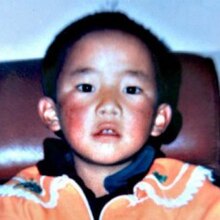
The Panchen Lama is a tulku of the Gelug school of Tibetan Buddhism. The Panchen Lama is one of the most important figures in the Gelug tradition, with its spiritual authority second only to the Dalai Lama. Along with the council of high lamas, he is in charge of seeking out the next Dalai Lama. Panchen is a portmanteau of Pandita and Chenpo, meaning "great scholar".
A tulku is a distinctive and significant aspect of Tibetan Buddhism, embodying the concept of enlightened beings taking corporeal forms to continue the lineage of specific teachings. The term "tulku" has its origins in the Tibetan word "sprul sku", which originally referred to an emperor or ruler taking human form on Earth, signifying a divine incarnation. Over time, this term evolved within Tibetan Buddhism to denote the corporeal existence of highly accomplished Buddhist masters whose purpose is to ensure the preservation and transmission of a particular lineage.

Chökyi Gyalpo, also referred to by his secular name Gyaincain Norbu or Gyaltsen Norbu, is considered the 11th Panchen Lama by the government of the People's Republic of China (PRC). He is also the vice president of the Buddhist Association of China. Gyalpo is considered by critics to be a proxy of the Chinese government.

Thubten Choekyi Nyima (1883–1937), often referred to as Choekyi Nyima, was the ninth Panchen Lama of Tibet.

Lobsang Trinley Lhündrub Chökyi Gyaltsen was the tenth Panchen Lama, officially the 10th Panchen Erdeni, of the Gelug school of Tibetan Buddhism. According to Tibetan Buddhism, Panchen Lamas are living emanations of the buddha Amitabha. He was often referred to simply as Choekyi Gyaltsen.

Khedrup Gyatso was the 11th Dalai Lama of Tibet.

Lungtok Gyatso, shortened from Lobzang Tenpai Wangchuk Lungtok Gyatso, was the 9th Dalai Lama of Tibet. He was the only Dalai Lama to die in childhood and was first of a string of four Dalai Lamas to die before reaching 22 years of age.

The 11th Panchen Lama controversy centers on the 28 year-long enforced disappearance of Gedhun Choekyi Nyima and on the recognition of the 11th Kunsik Panchen Lama. The Panchen Lama is considered the second most important spiritual leader in Tibetan Buddhism after the Dalai Lama. Following the death of the 10th Panchen Lama, the 14th Dalai Lama recognized Gedhun Choekyi Nyima in 1995. Three days later, the People's Republic of China (PRC) abducted the Panchen Lama and his family. Months later, the PRC chose Gyaincain Norbu as its proxy Panchen Lama. During the traditional search process led by Chadrel Rinpoche, he indicated to the Dalai Lama that all signs pointed to Gedhun Choekyi Nyima, while the Dalai Lamas and Panchen Lamas recognize each other's incarnations. The PRC had established its own search committee, which included Chatral Rinpoche and other monks, and wanted to use a lottery system referred to as the Golden Urn. Neither Gedhun Choekyi Nyima nor his family have been seen since the abduction. Chatral Rinpoche was also arrested by Chinese authorities the day of the abduction.
Gendün is a Tibetan personal name meaning "sangha". Gendün is its spelling in the Tournadre and THDL Simplified transcription systems; it is also written Dge-'dun in Wylie transliteration, Gêdün in Tibetan pinyin, Gendun, Gedun or Gedhun. Its pronunciation in the Lhasa dialect is.
Palden Tenpai Nyima (1782–1853) was the 7th Panchen Lama of Tibet.

Lobsang Tubten Jigme Gyatso (bot=བློ་བཟང་ཐུབ་བསྟན་འཇིགས་མེད་རྒྱ་མཚོ་), officially the 8th Arjia Hotogtu(bot=ཨ་ཀྱཱ་ཧོ་ཐོག་ཐུ།), born 1950 in Haiyan County, Qinghai) is one of the most prominent Buddhist teachers and lamas to have left Tibet. At age two, Arjia Rinpoche was recognized by Choekyi Gyaltsen, 10th Panchen Lama as the 20th Arjia Danpei Gyaltsen, the reincarnation of Je Tsongkhapa's father, Lumbum Ghe, the throne holder and abbot of Kumbum Monastery. He has trained with lineage teachers, such as the 14th Dalai Lama, the 10th Panchen Lama, and Gyayak Rinpoche—from whom he received many sacred teachings and ritual instructions.
State Religious Affairs Bureau Order No. 5, officially named Measures on the Management of the Reincarnation of Living Buddhas in Tibetan Buddhism, is an order passed during a conference of the State Administration for Religious Affairs on 13 July 2007, marked for implementation on 1 September 2007.
The Golden Urn is a method for selecting Tibetan reincarnations by drawing lots or tally sticks from a Golden Urn introduced by the Qing dynasty of China in 1793. After the Sino-Nepalese War, the Qianlong Emperor promulgated the 29-Article Ordinance for the More Effective Governing of Tibet, which included regulations on the selection of lamas. The Golden Urn was introduced ostensibly to prevent cheating and corruption in the selection process but also to position the Qianlong Emperor as a religious authority capable of adducing incarnation candidates. A number of lamas, such as the 8th and 9th Panchen Lamas and the 10th Dalai Lama, were confirmed using the Golden Urn. In cases where the Golden Urn was not used, the amban was consulted. Golden Urn was exempted for Lhamo Dhondup to become the 14th Dalai Lama in 1940.
The Changkya Khutukhtu was the title held by the spiritual head of the Gelug lineage of Tibetan Buddhism in Inner Mongolia during the Qing dynasty.

The International Tibet Network, established in 2000, is a global coalition of Tibet-related non-governmental organisations campaigning to end the China's occupation and human rights violations in Tibet, and restore rights to the Tibetan people. Its purpose is to maximise the effectiveness of the worldwide Tibetan Freedom Movement. The Network works to increase the capacity of individual member organisations, develops coordinated strategic campaigns, and encourages increased cooperation among organisations.
The incumbent 14th Dalai Lama once suggested the different possibilities of reincarnation for the next (15th) Dalai Lama, but because of the feudal origin of the Dalai Lama reincarnation system, he suggested the reincarnation system should end. The selection process remains controversial, as the atheist Chinese government has declared ownership on the selection process using the Golden Urn for the next Dalai Lama.
The 29-Article Ordinance for the More Effective Governing of Tibet was supposed to be an imperial decree published in 1793 by the Qianlong Emperor in the Qing dynasty, the last imperial dynasty of China. Article 1 states that the purpose of Golden Urn is to ensure prosperity of Gelug, and to eliminate cheating and corruption in the selection process. Article 12 states that relatives of the Dalai Lama or Panchen Lama must not hold government positions, or participate in political affairs.

Chadrel Rinpoche was born in 1939 in Shigatse, Tibet. He was also known formally as Jadrel Jampa Thinley Rinpoche, and was a Gelug school Rinpoche of Tibetan Buddhism. In 1954, he joined the Tashilhunpo Monastery at the age of 15, and was forced to work in a labor camp during the Cultural Revolution in Tibet. He was a close student of Choekyi Gyaltsen, the 10th Panchen Lama. Later Chadrel Rinpoche became the head Khenpo of the Tashilhunpo Monastery. In 1989, Chadrel Rinpoche was appointed to lead the Chinese efforts to locate the reincarnated 11th Panchen Lama. In February 1995 while in Beijing, he refused plans to substitute the reincarnate Gedhun Choekyi Nyima with another boy. As a result, he was arrested after Gedhun Choekyi Nyima was formally recognized, then he was continually imprisoned and held under house arrest until his reported suspicious death from poisoning in 2011. He was also a Member of the 7th and 8th Chinese People's Political Consultative Conference (CPPCC).
Reincarnated soul boy is a title used in the reincarnation process of living Buddhas in Tibetan Buddhism, it is a title for reincarnated practitioners before they formally become living Buddhas.












